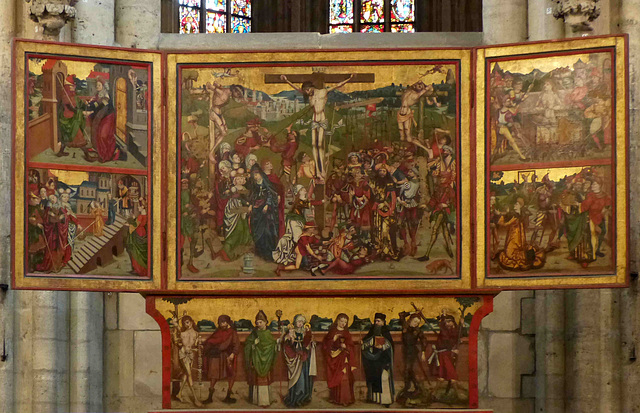Halberstadt - Dom zu Halberstadt
Halberstadt - St. Martini
Halberstadt - St. Martini
Halberstadt - St. Martini
Halberstadt - St. Martini
Halberstadt - St. Martini
Halberstadt - St. Martini
Halberstadt - Liebfrauenkirche
Halberstadt - Liebfrauenkirche
Halberstadt - Liebfrauenkirche
Halberstadt - Liebfrauenkirche
Halberstadt - Liebfrauenkirche
Halberstadt - Liebfrauenkirche
Halberstadt - Liebfrauenkirche
Halberstadt - Liebfrauenkirche
Halberstadt - Liebfrauenkirche
Halberstadt - Liebfrauenkirche
Halle - Marktplatz
Halle - Marktkirche Unserer Lieben Frau
Halle - Marktkirche Unserer Lieben Frau
Halle - Marktkirche Unserer Lieben Frau
Halle - Marktkirche Unserer Lieben Frau
Halle - Don´t worry be Curry
Halberstadt - Dom zu Halberstadt
Halberstadt - Dom zu Halberstadt
Halberstadt - Dom zu Halberstadt
Halberstadt - Dom zu Halberstadt
Halberstadt - Dom zu Halberstadt
Quedlinburg - Wunderschrank
Quedlinburg - St. Servatius
Quedlinburg - St. Servatius
Quedlinburg - St. Servatius
Quedlinburg - St. Servatius
Quedlinburg - St. Servatius
Quedlinburg - St. Servatius
Quedlinburg - St. Servatius
Quedlinburg - St. Servatius
Quedlinburg - St. Servatius
Quedlinburg - St. Nikolai
Quedlinburg - St. Wiperti
Quedlinburg - St. Wiperti
Quedlinburg - St. Wiperti
Quedlinburg - St. Wiperti
Quedlinburg - St. Wiperti
Quedlinburg - St. Wiperti
Location
Lat, Lng:
You can copy the above to your favourite mapping app.
Address: unknown
You can copy the above to your favourite mapping app.
Address: unknown
See also...
Keywords
Authorizations, license
-
Visible by: Everyone -
All rights reserved
-
85 visits
Halberstadt - Dom zu Halberstadt


Through Charlemagne, the mission base here became a bishop's see in 804. The Bishop was granted market, minting and customs rights by King Otto III in 989. He held the secular power in the Harzgau and thus over the inhabitants of Halberstadt. The first cathedral was consecrated in 992.
By 1068, there was already an emerging merchant class, under which the city began to emancipate itself from control by the bishop's see around about 1105. In 1146, possibly the first Jews arrived in Halberstadt coming from Halle. In 1189 Jews persecuted during the Third Crusade reached the city. In 1261, the first episcopal letter of protection is documented for them.
Henry the Lion destroyed the city, cathedral and cathedral castle in 1179 in the course of a feud by setting a major fire. In 1199 the construction of the city wall is mentioned for the first time, which lasted until 1236. Between 1236 and 1239, the construction of the new cathedral began. In 1241, a town hall for the city is mentioned for the first time; moreover, the city already had its own seal at this time. In 1343 the Jews were attacked by the Counts of Mansfeld and Regenstein and fled, a decade later the new so-called "Judendorf" became the first closed Jewish settlement in the city.
The present-day cathedral was built between 1236/39 and 1491 in a Gothic style, inspired by the French Gothic cathedrals. In 1591 the Bishop of Halberstadt joined the Protestant Reformation, and the church has been used by the Protestant Church since. The cathedral was severely damaged in WWII, but has been restored in the decades after the war.
The winged altar from around 1480. In the center is the crucifixion with many figures, scenes from the life of Mary and the life of the two Johns on wings. On the predella an "Anna selbdritt" and seven male saints.
By 1068, there was already an emerging merchant class, under which the city began to emancipate itself from control by the bishop's see around about 1105. In 1146, possibly the first Jews arrived in Halberstadt coming from Halle. In 1189 Jews persecuted during the Third Crusade reached the city. In 1261, the first episcopal letter of protection is documented for them.
Henry the Lion destroyed the city, cathedral and cathedral castle in 1179 in the course of a feud by setting a major fire. In 1199 the construction of the city wall is mentioned for the first time, which lasted until 1236. Between 1236 and 1239, the construction of the new cathedral began. In 1241, a town hall for the city is mentioned for the first time; moreover, the city already had its own seal at this time. In 1343 the Jews were attacked by the Counts of Mansfeld and Regenstein and fled, a decade later the new so-called "Judendorf" became the first closed Jewish settlement in the city.
The present-day cathedral was built between 1236/39 and 1491 in a Gothic style, inspired by the French Gothic cathedrals. In 1591 the Bishop of Halberstadt joined the Protestant Reformation, and the church has been used by the Protestant Church since. The cathedral was severely damaged in WWII, but has been restored in the decades after the war.
The winged altar from around 1480. In the center is the crucifixion with many figures, scenes from the life of Mary and the life of the two Johns on wings. On the predella an "Anna selbdritt" and seven male saints.
Marco F. Delminho, Paolo Tanino have particularly liked this photo
- Keyboard shortcuts:
Jump to top
RSS feed- Latest comments - Subscribe to the comment feeds of this photo
- ipernity © 2007-2025
- Help & Contact
|
Club news
|
About ipernity
|
History |
ipernity Club & Prices |
Guide of good conduct
Donate | Group guidelines | Privacy policy | Terms of use | Statutes | In memoria -
Facebook
Twitter

Sign-in to write a comment.